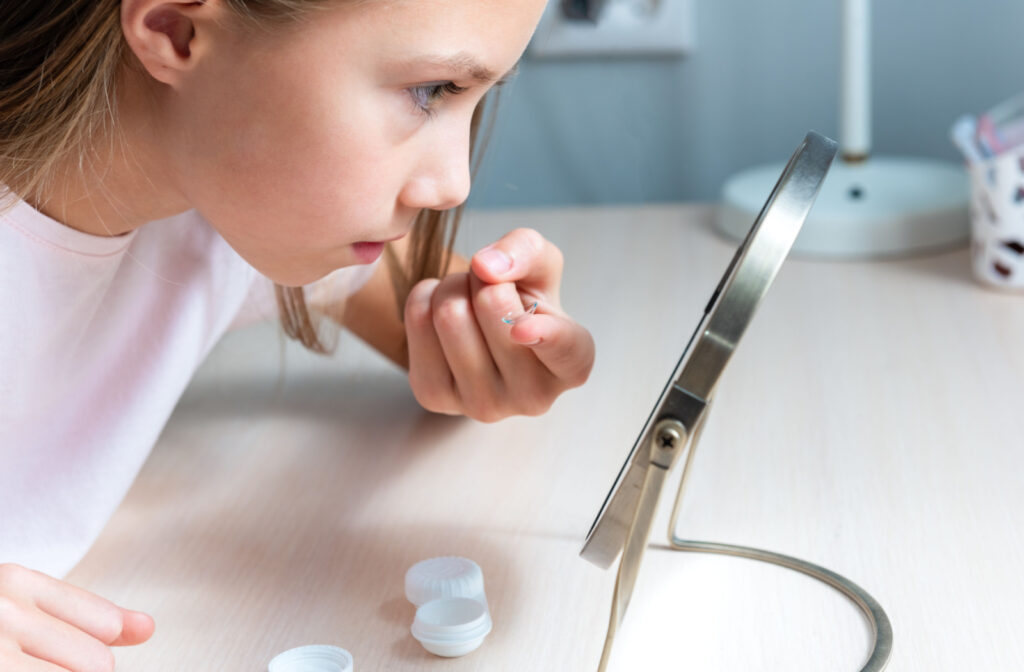Myopia is a common vision error where our eyes don’t focus light correctly, causing distant objects to appear blurry while close ones remain clear. But concern around myopia is more than simply being about clear vision. Myopia can lead to serious vision problems in the future if left unchecked. But myopia control can help.
Contact lenses are a myopia control method that simultaneously corrects blurry vision and slows myopia progression in children. Different types of myopia control contacts and other approaches include prescription eyeglasses and atropine eye drops.
There isn’t a one-size-fits-all answer for the “best” myopia control. It ultimately depends on factors like your child’s age, eye shape and size, and the severity of myopia. So, the first step is a comprehensive eye examination. Your child’s optometrist can guide you in the right direction for preserving your child’s vision.
Understanding Myopia
Myopia, also known as nearsightedness, is a refractive error, meaning the shape of the eye prevents light from focusing correctly on the retina, resulting in distant objects appearing blurry. Myopia typically develops during childhood (around ages 6–12) and can progress throughout adolescence.
What Causes Myopia?
Myopia is a complex vision condition with several influencing factors.
It can occur due to a genetic predisposition, so children whose parents have myopia are more likely to also get myopia. It can also be caused by increased close work and not enough time spent outdoors while the eyes are developing. Living in a highly urbanized area or being exposed to excessive screen time can also contribute to the development and progression of myopia.
Symptoms of Myopia
Trouble with clear distance vision is the primary symptom of myopia, but other symptoms can include:
- Headaches
- Eye strain
- Squinting
- Eye fatigue during focus-intensive work
Children may not always recognize an issue with their vision because it’s normal for them. Myopia in children may present with:
- Poor school performance
- A short attention span
- Holding things close to their face
- Trying to sit near the front of the class
These symptoms can all indicate that myopia could be the issue, but other eye conditions can present with similar symptoms, so it’s essential that your child sees their optometrist for a comprehensive eye examination for an accurate diagnosis. This way, their eye doctor can rule out any other childhood vision problems.
Why Should We Control Myopia in Children?
Myopia can advance into high myopia or pathological myopia. These advanced forms of myopia raise the risk of severe, potentially sight-threatening conditions, such as glaucoma, myopic macular degeneration, cataracts, and retinal detachment. However, there are no safe levels of myopia, and low levels also pose increased eye health risks.
Children’s eyes grow rapidly, and their visual system is still developing during childhood, making it an ideal time to intervene and reduce the risk of high myopia.
Myopia control strategies can lessen their future risk of myopia by slowing or stopping myopic progression.
Myopia Control Contact Lenses
There are 2 main types of myopia control contact lenses. Your child’s optometrist can recommend the right option for your child.
Soft Contact Lenses
Contact lenses designed for myopia control are similar to multifocal lenses. They contain different zones of vision correction, with one zone for distance and another for near vision, which allows the eyes to focus on objects at various distances.
Standard single-vision glasses focus peripheral light rays behind the retina, leading to increased eye growth. Myopia control contacts focus peripheral light rays in front of the retina, promoting slower eye growth and reducing myopia progression.
CooperVision MiSight 1 day contacts are FDA-approved for myopia control in children as young as 8. They are disposable daily-wear lenses, making them a convenient option with minimal maintenance required.
Orthokeratology
Gentle Vision Shaping (orthokeratology or ortho-k) is a custom-made rigid gas-permeable contact. They’re worn overnight and gently reshape the cornea, reducing or eliminating the need for daytime correction. Ortho-k is safe for children, and its vision-correcting properties are reversible, making it a popular choice.
Current research indicates that ortho-k can slow myopia progression by approximately 50%, but efforts are underway to enhance this technology.
Additional Methods for Myopia Control
Contact lenses are an excellent option for myopia control in many cases, but there may be times when your child’s optometrist recommends a different or combined approach.
Atropine Eye Drops
Atropine is a medication that relaxes your eye muscles. It’s used to dilate the pupils during a dilated eye exam, but it’s also used to slow myopia progression. Atropine eye drops are prescribed in a low concentration and applied nightly to the eye. While effective, some side effects may include sensitivity to light and difficulty focusing on near objects.
Prescription Eyeglasses
Prescription myopia control eyeglasses are currently in FDA trials and may one day be a convenient option for those who prefer not to use contact lenses or eye drops. These glasses are customized with a specific lens design and power to help slow the progression of myopia. They can be worn throughout the day and also correct vision as needed.
The most effective lens options for myopia control are special designs with “lenslets”—small mini-lenses scattered across the main lens surface. Another design using light diffusion has also shown promising results.
Bifocal lenses can moderately slow myopia progression, while progressive addition lenses have minimal impact compared to these options.
Learn More About Myopia Control from Your Child’s Optometrist
There’s no need to worry if your child has myopia, but it’s a good idea to schedule a comprehensive eye exam if they show any signs of nearsightedness. Contact our team at Signature Eye Care to request an appointment. One of our experienced optometrists can examine your child’s eyes and determine how to proceed with correction or with myopia control.



